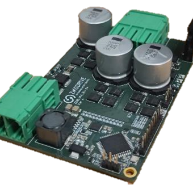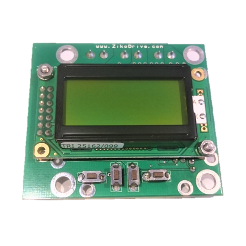What is a motor controller?
Motor controllers are at the heart of countless modern machines, from electric cars and drones to factory automation and household appliances. Whether you realize it or not, almost every device that uses an electric motor relies on a controller to function safely, efficiently, and precisely. But what exactly is a motor controller, how does it work, and why is it so important?
This article explores the role of motor controllers, their different types, applications, and the key considerations when choosing one.
The Definition of a Motor Controller
At its simplest, a motor controller is an electronic device that regulates the operation of an electric motor. It acts as the interface between the power source and the motor, controlling factors such as speed, torque, and direction.
Without a controller, an electric motor would simply run uncontrolled at full power whenever connected to electricity—something that is rarely useful in practice and often unsafe. By controlling the flow of electrical energy, the controller ensures the motor delivers exactly the performance required for the task at hand.

Why Motor Controllers Matter
Electric motors are highly versatile, but they are not inherently intelligent. A bare motor has no ability to regulate itself. The motor controller provides:
- Precision: Fine control over speed and position, essential for robotics, CNC machines, and medical devices.
- Efficiency: Optimized power delivery to minimize energy loss, critical for battery-powered systems like electric vehicles.
- Protection: Safeguards against overcurrent, overheating, and short circuits to extend the motor’s life.
- Flexibility: Ability to reverse direction, ramp speeds smoothly, and adapt to different load conditions.
Put simply, the controller unlocks the full potential of the motor.

How Motor Controllers Work
The specific operation of a motor controller depends on the motor type it is driving. However, most controllers share a few common building blocks:
-
Power Electronics
- Transistors (such as MOSFETs or IGBTs) act as electronic switches to regulate current to the motor.
- Pulse Width Modulation (PWM) techniques chop up the voltage into high-frequency pulses, allowing precise speed control.
-
Control Logic
- A microcontroller, DSP, or dedicated control IC interprets user commands or sensor feedback and decides how the motor should respond.
- Algorithms such as Field-Oriented Control (FOC) or trapezoidal control determine how power is applied.
-
Feedback and Sensors
- Encoders, Hall-effect sensors, or back-EMF measurement provide information on position, speed, and load.
- Closed-loop control uses this feedback to correct errors and improve accuracy.
-
Protection Circuits
- Overcurrent detection, thermal shutdown, and soft-start functions help protect both the motor and the controller itself.
Types of Motor Controllers
Because motors come in many varieties, motor controllers also differ widely in design and function. The main categories include:
1. DC Motor Controllers
Used with brushed DC motors, these are relatively simple. By varying the voltage or duty cycle of a PWM signal, the controller adjusts motor speed. Reversing polarity changes direction.
2. Stepper Motor Controllers
Stepper motors move in discrete steps, making them ideal for precise positioning in 3D printers and CNC machines. Controllers send timed pulses to move the motor step by step, often with microstepping techniques for smooth motion.
3. AC Motor Controllers (Variable Frequency Drives, or VFDs)
AC induction and synchronous motors are common in industrial applications. VFDs adjust the frequency and amplitude of the AC supply to regulate speed and torque efficiently.
4. Brushless DC (BLDC) and Permanent Magnet Synchronous Motor (PMSM) Controllers
These motors require electronic commutation, which is handled entirely by the controller. Advanced techniques like FOC deliver smooth, efficient performance—essential for electric vehicles, drones, and robotics.
Applications of Motor Controllers
Motor controllers are everywhere, often hidden behind the scenes:
- Transportation: Electric cars, trains, and e-bikes all rely on sophisticated motor controllers for acceleration, regenerative braking, and efficiency.
- Industrial Automation: Robotics, conveyor belts, pumps, and machine tools all require precise motor control.
- Consumer Electronics: Fans, washing machines, and hard drives use small-scale controllers to regulate operation.
- Aerospace and Drones: Lightweight, high-performance controllers are critical for flight stability and battery life.
- Medical Equipment: Devices like infusion pumps and surgical robots demand high precision and reliability.
In each case, the controller transforms raw electrical energy into controlled, useful mechanical motion.

Key Features to Look For
When selecting or designing a motor controller, engineers typically consider:
- Voltage and Current Ratings: Must match the motor and power supply.
- Control Method: Simple open-loop vs. closed-loop with feedback.
- Efficiency: Especially important in battery-powered systems.
- Communication Interfaces: USB, CAN, UART, or Ethernet for integration with larger systems.
- Programmability: Ability to adjust parameters or run custom control algorithms.
- Size and Thermal Management: Compact designs with good heat dissipation are often required.

Challenges in Motor Control
While the principles are straightforward, implementing motor control is complex:
- Electromagnetic Interference (EMI): Fast switching can cause noise that must be managed.
- Thermal Management: Controllers must dissipate heat from high-power switching devices.
- Dynamic Loads: Motors that drive unpredictable or varying loads require adaptive control strategies.
- Cost vs. Performance Trade-offs: High-precision control often demands more expensive hardware and software.
Modern motor controllers often integrate advanced features like AI-based predictive control, IoT connectivity, and energy recovery systems to tackle these challenges.
The Future of Motor Controllers
The demand for smarter, more efficient motor controllers continues to grow. Key trends include:
- Integration with IoT: Controllers that communicate data about performance, wear, and efficiency to cloud platforms.
- Energy Efficiency Regulations: Stricter standards are driving innovation in low-loss switching technologies.
- Electrification of Transportation: Electric vehicles, eVTOL aircraft, and micromobility are pushing motor controllers to new levels of performance.
- Customization and Flexibility: More modular, programmable controllers allow adaptation to a wide range of applications.